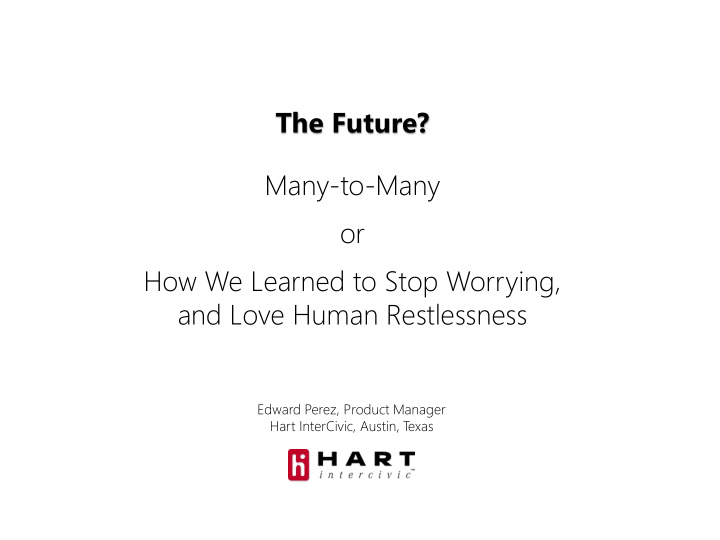



The Future? Many-to-Many or How We Learned to Stop Worrying, and Love Human Restlessness Edward Perez, Product Manager Hart InterCivic, Austin, T exas
1. the approach focus on the human needs
human-centered design focus on human needs usability, adaptability, transparency assume that humans will be fickle and creative and try to get ready for that
2. the solutions many-to-many
The next logical step in the technological revolution connecting people anytime, anywhere is to connect inanimate objects. This is the vision underlying the Internet net of f things gs: anytime, anywhere, by anyone and anything. - International T elecommunication Union, Geneva, 2005
many-to-many more participation, more devices, more modalities
Information Technology & Innovation Foundation Home-based access Remote voting options • • Use home computers to download Portable election “kiosks” in • • & mark ballots care facilities (e.g., tablets) Online rating systems for polling Online interactive voters’ • • places, like “Yelp” guides Online voter education profiles Automated deadline • • for receipt of VEO materials in reminders via phone, text or different formats email (absentee ballots, Election Day voting) Online polling place accessibility • information Use familiar technology to vote • (phones, ATMs, televisions) Ridesharing to facilitate carpools • to voting locations Online wait times for polling • places Barcodes to transfer voting choices • Mobile voting vans • Drive-thru voting • Online poll worker training • iPad/Tablet voting • Smartphone apps , to enable • mobile voting from anywhere in the world
usability adaptability transparency access innovation openness
3. the challenges catching up to the pace of change
Getting the standards in line with innovation Diversity of devices vs. flattening thrust of complex standards Fewer configurations, or many? Getting our laws in line with innovation Laws can either support or restrict new methods of participation Changing outdated/unusable ballot designs Voter access (registration, convenience voting, etc.) Allowing new kinds of technology Right-sizing the technology Competing values – access, security, usability, cost, etc.
Recommendations - Technology 1. Certify what’s necessary – no more, no less . Enlarge & clarify distinction between “election management“ vs. “voting system.” 2. Facilitate the use of cost-effective transferable technologies. Allow the incorporation of more commercial-off-the-shelf hardware, in a traceable, safe, cost-effective way, without requiring full re- certification. 3. Devise procedures for software modifications. Consider methods to safely and reliably enable incremental changes to be made to certified software applications (i.e. de minimis changes). 4. Leave design to the technologists . Aim for standards that do not over-prescribe specific solutions, which can increase cost and complexity; identify problems to be prevented, rather than specific implementations.
usability technology adaptability by the many, transparency for the many access innovation openness
many is a beautiful thing
thank you eperez@hartic.com
Recommend
More recommend